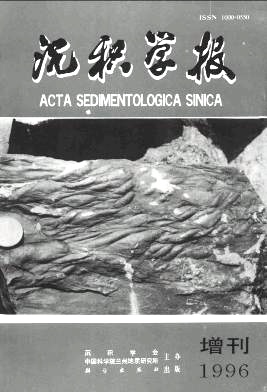Meng Qingren, Mei Zhichao, Yu Zaiping, Zhang Guowei. Late Devonian Turbidite System and Tectonics of Zhen'an Basin at Northern Margin of South Qinling[J]. Acta Sedimentologica Sinica, 1996, 14(S1): 25-32.
| Citation:
|
Meng Qingren, Mei Zhichao, Yu Zaiping, Zhang Guowei. Late Devonian Turbidite System and Tectonics of Zhen'an Basin at Northern Margin of South Qinling[J]. Acta Sedimentologica Sinica, 1996, 14(S1): 25-32.
|
Late Devonian Turbidite System and Tectonics of Zhen'an Basin at Northern Margin of South Qinling
-
1 Institute of Geophysics, Academia Sinica, Beijing 100101;
-
2 Department of Geology, Northwest University, Xi'an 710069
- Received Date: 1996-04-28
- Publish Date:
1996-12-31
-
Abstract
Zhen'an basin, situated at the northern margin of South Qinling, is bounded to the north by the Shanyang fault and to the south by the Banyanzhen fault, respectively. It was a rifted basin and filled mainly with siliciclastic turbidites during Late Devonian.The turbidite system is made up of the Jiuliping formation (Upper Devonian), which can be divided spacially into two segments, the northern Jiuliping formation and southern Jiuliping formaion, according to facies characteristics. The lower part of the northern Jiuliping formation is composed of slope fine-grained sediments, inclusive of hemipelagites and fine-grained turbidites, but commonly cut by gullies which are filled with coarse-grained gravity-flow deposits. In contrast, the lower part of the southern Jiuliping formation consists of channel-levee and lobe deposits, but typical thinning-and-fining-upward, or thickening-and-coarseningupward sequences are not well developed. The channel-levee and lobe units are blanketed with basin plain deposits, they are then changed into thin-layered deep-water carbonate rocks.Clearly, the whole Upper Devonian sequences show a deepening-upward tendency. In addition, it is demonstrated on the basis of analysis of paleocurrents and source areas that the siliciclastic turbidite system was fed from a linear source area to the north, but turbidity current was deflected eastwards along the basin axis. The turbidite system studied is not a classical submarine fan but one that has much in common with the ramp turbidite system model.The turbidite system and basin development are apparently influenced by tectonism, sealevel fluctuation and sediment supply. The rifting leads to the drowning of Middle Devonian carbonate platform and the initiation of siliciclastic turbidite system, and the uppermost deepwater carbonate rocks or carbonate turbidites are believed to be related to sea-level rising. The Late Devonian initiation and development of Zhen'an Basin resulted from the peripheral upwell and induced extension in the upper crust at the northern margin of the subducting South Qinling plate in consideration of regional tectonism.
-
References
|
[1]
|
1.张国伟等.秦岭造山带的形成及其演化.西安:西北大学出版社,1988. 129.
2.孟庆任.秦岭晚古生代沉积作用,盆地发展和构造演化.博士论文,西北大学,1994. 187.
3.孟庆任,梅志超,于在平,崔智林.秦岭板块北缘一个消失了的泥盆纪古陆.科学通报,1995, 40: 611-646.
4.Bradley D C and Kidd W S F. Flexural extension of the upper continental crust in coVisional foredeeps. BuV. Geol. Soc.Am. 1991,103: 1416-1438.
5.Heller P L and Dickinson W R. Submarine ramp facies model for delta-fed sandrich turbidite system. Bull. AAPC.1985. 69: 960-976.
6.Lash G G. Sedimentology of channelized turbidite deposits in an ancient (Early Paleozoic) subduction complex. central Appalachians. Bull. Geol. Soc. Am.,1986. 97:703-710.
7.Leeder M R and Gawthrope R 1.Sedimentary models for extensional tilt一block/half一graben basins. Geol. Soc. Spec.Publ. London. 1987. 28: 139-152.
8.Mutti E. Instinctive thin一bedded turbidite facies and related depositional environments in the Eocene Hecho Group(Southcentral Pyrenees. Spain). Sedimentology. 1977,24:107-131.
9.Mutti E and Ricci Lucchi F. Turbidites from the northern Appenines; Introduction to facies analysis, lnt. Geol. Rev.1978. 19:125一168.
10.Schlager W. The paradox of drowned reefs and carbonate platform. Bull. Geol. Sac. Am. 1981,92:197-211.
11.Shanmugam G and Moiola R G. Eustatic control of turbidites and winnowed turbtdites. Geology. 1982. 10: 231一235.
12.Shanmugam G and Moiola R G. Submarine fans: characteristics, models, classification and reservoir potential. Earth Sci. Rev. 1988. 24:383-428.
13.Shanmugam G and Muiola R G. Types of submarine fan lobes: models and implications. Bull. AAPG. 1991,75:156-179.
14.Stow D A V and Piper D J W. Deep一water fine一grained sediments; Facies models. Geol. Soc. Spec. Publ. Lon-don, 1984,15:611一646.
15.Surlyk F. Slope and deep shelf gully sandstones. Upper Jurassic. East Greenland. Bull. AAYG. 1987,71:464- 475.
16.Walker R G. Mudstones and thin一bedded turbidites ass,xiated with the Upper Cretaceous Wheeller Groge Conglomer-arcs, California, a possible channel一levee complex. J. Sed. Yet.,1985. 55:179-290. |
-
-
Proportional views

-






 DownLoad:
DownLoad: